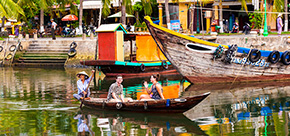Fact: it is impossible to take a bad picture in Hoi An. I would know because I tried, and failed. The perfect combination of culture and colour, Hoi An is the supermodel of cities, it has no bad angle.
Culture
Situated halfway down the east coast, between Hanoi in the north and Saigon in the south, Hoi An is a rich architectural fusion of Chinese, Japanese, Vietnamese and European influences. Originally the international trading centre for Southern Vietnam in the 16th and 17th centuries, Hoi An has been on the UNESCO World Heritage list since 1999.
Stubbornly traditional, a dedicated effort has been made to preserve Hoi An’s old-world charm. With narrow streets lined with wooden-fronted shop-houses, it is the only place in Vietnam that places restrictions on motorbikes – walking and cycling are most definitely encouraged.
The ancient town of Hoi An has a tourist scheme whereby, with one ticket, you can visit any five of the 23 listed sights and streets in the Old Town. Valid for one day, the proceeds of all tickets contribute to presevering the Old Town.
Japanese Covered Bridge
The Japanese Covered Bridge is, without doubt, the most photographed sight in Hoi An. Built in the former Japanese quarter, this small arched red bridge has been adopted as Hoi An’s emblem.
Merchant houses
The most famous merchant houses are along Tran Phu, many of which are more than 200 years old and are still inhabited by the descendants of prosperous Chinese traders. Visit the houses of the Phung Hung, Tan Ky, QuanThang and Duc An families.
Family chapels
Similar to the merchant homes are the two family chapels, built by wealthy Chinese merchants in the eighteenth century, reflecting their individual spiritual focus.
Assembly halls
Hoi An’s ethnic Chinese population organised themselves according to their place of origin, with each group maintaining their own assembly hall. Both a community centre and a house of worship, these assembly halls can still be visited today.
Museums
Comprising of four fairly modest historical museums, choose between the Museum of Trade Ceramics, Folk Culture, Sa Huynh Culture or Hoi An History and Culture.
Colour
Calling Hoi An vibrant is an understatement. Local businesses are required by law to dangle lanterns from their facades, so every street in Hoi An bursts with colour.
Taking inspiration from the primary colour palette, jolly yellow buildings with red lanterns contrast against green foliage and blue skies. Temples are a technicoloured dream, as are the endless sea of multi-coloured lanterns strung high above most of the main streets.
Colour isn’t confined to the streets either. On the Thu Bon River, bright blue boats with yellow flowers proudly fly the red Vietnamese flag, instantly recognisable by its yellow star.
Between the culture, colour and a culinary scene that ranks among the best in Asia, Hoi An is an essential stop on any tour of Vietnam, or is enjoyable as a destination in itself.

